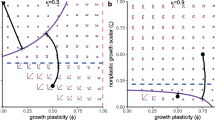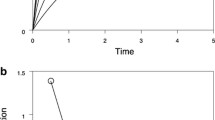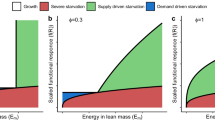Abstract
We compare the implications of determinate vs. indeterminate growth of a parthenogenetic iteroparous ectotherm at constant food density in the context of the dynamic energy budget theory, which specifies the tight links between life history traits, such as feeding, aging, growth and reproduction. We do a comparative analysis using, as measure of fitness, the life span reproduction, the population growth rate, and the conversion efficiency of food to biomass. When extrinsic mortality is constant, indeterminate growth cannot maximize fitness if measured by the population growth rate or the conversion efficiency, except when mortality is low, in which case both types of animals are similar. If the fitness measure is life span reproduction, indeterminate growth maximizes fitness even with constant mortality, provided it is not very high. When mortality decreases with size, indeterminate growth maximizes fitness for almost all measures of fitness. Finally, we suggest an evolutionary link between allocation strategies and expected life span. In populations of long living species, each type of animal can establish in the population of the other. In populations of short living species, determinate growers can invade, and displace, a population of indeterminate ones. However, when the mortality risk of organisms with small size is much higher than those of large size, indeterminate growers can be superior.
Similar content being viewed by others
References
Bulmer, M. (1994). Theoretical Evolutionary Ecology, Sinauer.
Calow, P. (1981). Resource utilization and reproduction, in Physiological Ecology; An Evolutionary Approach to Resource Use, C. E. Townsend and P. Calow (Eds), Blackwell, pp. 245–270.
Charnov, E. L. (1993). Life History Invariants; Some Explorations of Symmetry in Evolutionary Ecology, Oxford University Press.
Engen, S. and B. E. Sæther (1994). Optimal allocation of resources to growth and reproduction. Theor. Popul. Biol. 46, 232–248.
Finch, C. (1990). Longevity, Senescence, and the Genome, University of Chicago Press.
Fisken, Ø. (1997). Allocation patterns and diel vertical migration: modeling the optimal daphnia. Ecology 78, 1446–1456.
Gabriel, W. (1982). Modelling reproductive strategies of daphnia. Arch. Hydrobiol. 95, 69–80.
Gurney, W. C. and D. A. J. Middleton (1996). Optimal resource allocation in a randomly varying environment. Funct. Ecol. 10, 602–612.
Heino, M. and V. Kaitala (1996). Optimal resource allocation between growth and reproduction in clams: why does indeterminate growth exists? Funct. Ecol. 10, 245–251.
Heino, M. and V. Kaitala (1999). Evolution of resource allocation between growth and reproduction in animals with indeterminate growth. J. Evol. Biol. 12, 423–429.
Iwasa, Y. and D. Cohen (1989). Optimal growth schedule of perennial plant. Am. Natural. 133, 480–505.
Kleiber, M. (1932). Body size and metabolism. Hilgardia 6, 315–353.
Kooijman, S. A. L. M. (2000). Dynamic Energy and Mass Budgets in Biological Systems, Cambridge University Press.
Kooijman, S. A. L. M. (2001). Quantitative aspects of metabolic organization; a discussion of concepts. Phil. Trans. R. Soc. B 356, 331–349.
Kozłowski, J. (1992). Optimal allocation of resources to growth and reproduction: implications for age and size at maturity. Trends Ecol. Evol. 7, 15–19.
Kozłowski, J. (1993). Measuring fitness in life-history studies. Trends Ecol. Evol. 8, 84–85.
Kozłowski, J. (1996). Optimal initial size and adult size of animals: consequences for macroevolution and community structure. Am. Natural. 147, 101–114.
Leeuwen, I. M. M. v., F. D. L. Kelpin and S. A. L. M. Kooijman (2002). A mathematical model that accounts for the effects of caloric restriction on body weight and longevity. Biogerontology (to appear).
Lika, K. and R. M. Nisbet (2000). A dynamic energy budget model based on partitioning of net production. J. Math. Biol. 41, 361–386.
Masoro, E. J. and S. N. Austad (1996). The evolution of the antiaging action of dietary restriction: a hypothesis. J. Gerontol. Biol. Sci. A 51, B387–B391.
Maynard Smith, J. (1982). Evolution and the Theory of Games, Cambridge University Press.
Meszéna, G. and E. Pásztor (1990). Population regulation and optimal life-history strategies, in Organizational Constraints on the Dynamics of Evolution, J. Maynard Smith and G. Vida (Eds), Manchester University Press, pp. 321–331.
Metz, J. A. J., R. M. Nisbet and S. A. H. Geritz (1992). How should we define ‘fitness’ for general ecological scenarios? Trends Ecol. Evol. 7, 198–202.
Mylius, S. D. and O. Diekmann (1995). On evolutionarily stable life histories, optimization and the need to be specific about density dependence. Oikos 74, 218–224.
Nisbet, R. M., E. B. Muller, K. Lika and S. A. L. M. Kooijman (2000). From molecules to ecosystems through dynamic energy budget models. J. Anim. Ecol. 69, 913–926.
Perrin, N. (1992). Optimal resource allocation and the marginal value of organs. Am. Natural. 139, 1344–1369.
Perrin, N. and R. M. Silby (1993). Dynamic models of energy allocation and investment. Ann. Rev. Ecol. Systemat. 24, 379–410.
Perrin, N., R. M. Silby and N. K. Nichols (1993). Optimal growth strategies when mortality and production rates are size-dependent. Evolutionary Ecol. 7, 576–592.
Roff, D. A. (1992). The Evolution of Life Histories; Theory and Analysis, Chapman and Hall.
Ross, A. H. and R. M. Nisbet (1990). Dynamic models of growth and reproduction of the mussel Mytilus edulis L. Funct. Ecol. 4, 777–787.
Sibly, R. M., P. Calow and N. Nichols (1985). Are patterns adaptive? J. Theor. Biol. 112, 553–574.
Stearns, S. C. (1992). The Evolution of Life Histories, Oxford University Press.
Taylor, B. and W. Gabriel (1992). To grow or not to grow: optimal resource allocation for Daphnia. Am. Natural. 139, 248–266.
Taylor, B. and W. Gabriel (1993). Optimal growth of Daphnia in seasonal environment. Funct. Ecol. 7, 513–521.
Taylor, H. M., R. S. Gourley, C. E. Lawrence and R. S. Kaplan (1974). Natural selection of life history attributes: an analytical approach. Theor. Popul. Biol. 5, 104–122.
Whithers, P. C. (1992). Comparative Animal Physiology, Fort Worth: Saunders College Publishing.
Author information
Authors and Affiliations
Corresponding author
Rights and permissions
About this article
Cite this article
Lika, K., Kooijman, S.A.L.M. Life history implications of allocation to growth versus reproduction in dynamic energy budgets. Bull. Math. Biol. 65, 809–834 (2003). https://doi.org/10.1016/S0092-8240(03)00039-9
Received:
Accepted:
Issue Date:
DOI: https://doi.org/10.1016/S0092-8240(03)00039-9




